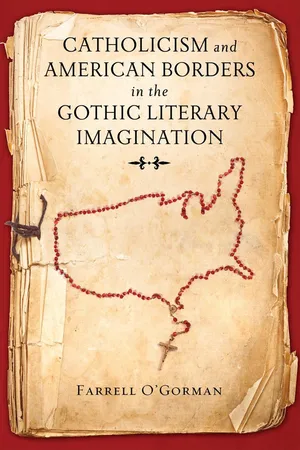
- 368 pages
- English
- ePUB (mobile friendly)
- Available on iOS & Android
Catholicism and American Borders in the Gothic Literary Imagination
About this book
In Catholicism and American Borders in the Gothic Literary Imagination, Farrell O'Gorman presents the first study of the recurrent role of Catholicism in a Gothic tradition that is essential to the literature of the United States. In this tradition, Catholicism is depicted as threatening to break down borders separating American citizens—or some representative American—from a larger world beyond. While earlier studies of Catholicism in the American literary imagination have tended to highlight the faith's historical association with Europe, O'Gorman stresses how that imagination often responds to a Catholicism associated with Latin America and the Caribbean. On a deeper level, O'Gorman demonstrates how the Gothic tradition he traces here builds on and ultimately transforms the persistent image in modern Anglophone literature of Catholicism as "a religion without a country; indeed, a religion inimical to nationhood." O'Gorman focuses on the work of J. Hector St. John de Crèvecœur, Herman Melville, Kate Chopin, William Faulkner, Flannery O'Connor, Walker Percy, Cormac McCarthy, and selected contemporary writers including Toni Morrison. These authors, representing historical periods from the early republic to the present day, have distinct experiences of borders within and around their nation and hemisphere, itself an ever-emergent "America." As O'Gorman carefully documents, they also have distinct experiences of Catholicism and distinct ways of imagining the faith, often shaped at least in part within the Church itself. In their narratives, Catholicism plays a complicated and profound role that ultimately challenges longstanding notions of American exceptionalism and individual autonomy. This analysis contributes not only to discourse regarding Gothic literature and nationalism but also to a broader ongoing dialogue regarding religion, secularism, and American literature.
Frequently asked questions
- Essential is ideal for learners and professionals who enjoy exploring a wide range of subjects. Access the Essential Library with 800,000+ trusted titles and best-sellers across business, personal growth, and the humanities. Includes unlimited reading time and Standard Read Aloud voice.
- Complete: Perfect for advanced learners and researchers needing full, unrestricted access. Unlock 1.4M+ books across hundreds of subjects, including academic and specialized titles. The Complete Plan also includes advanced features like Premium Read Aloud and Research Assistant.
Please note we cannot support devices running on iOS 13 and Android 7 or earlier. Learn more about using the app.
Information
NOTES
INTRODUCTION
Table of contents
- Cover
- Half title
- Title
- Copyright
- Dedication
- Contents
- Acknowledgments
- Introduction
- Crèvecoeur’s Mask of the Modern: Roman Ruins and America’s “New Man”
- Melville’s “Monkish Fables”: Catholic Bodies Haunting the New World
- Fear, Desire, and Communion in Chopin’s Old La Louisiane
- Waste Lands, Border Histories, Gothic Frontiers: Faulkner, McCarthy, Percy
- O’Connor’s “True Country”: Borders, Crossings, Pilgrims
- Coda: Catholicism, American Borders, and the Gothic in Contemporary U.S. Fiction
- Notes
- Bibliography
- Index